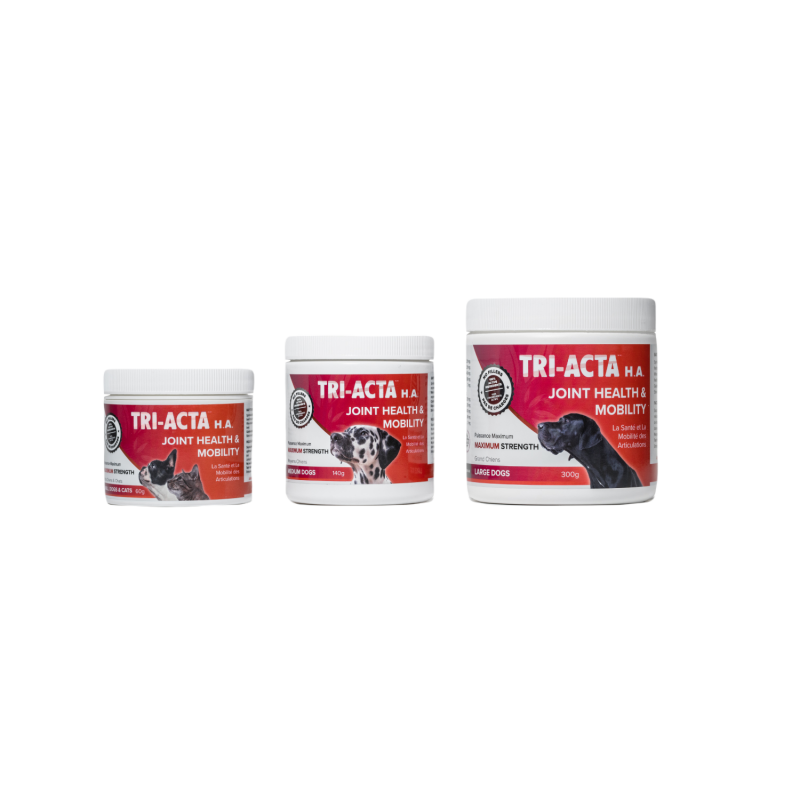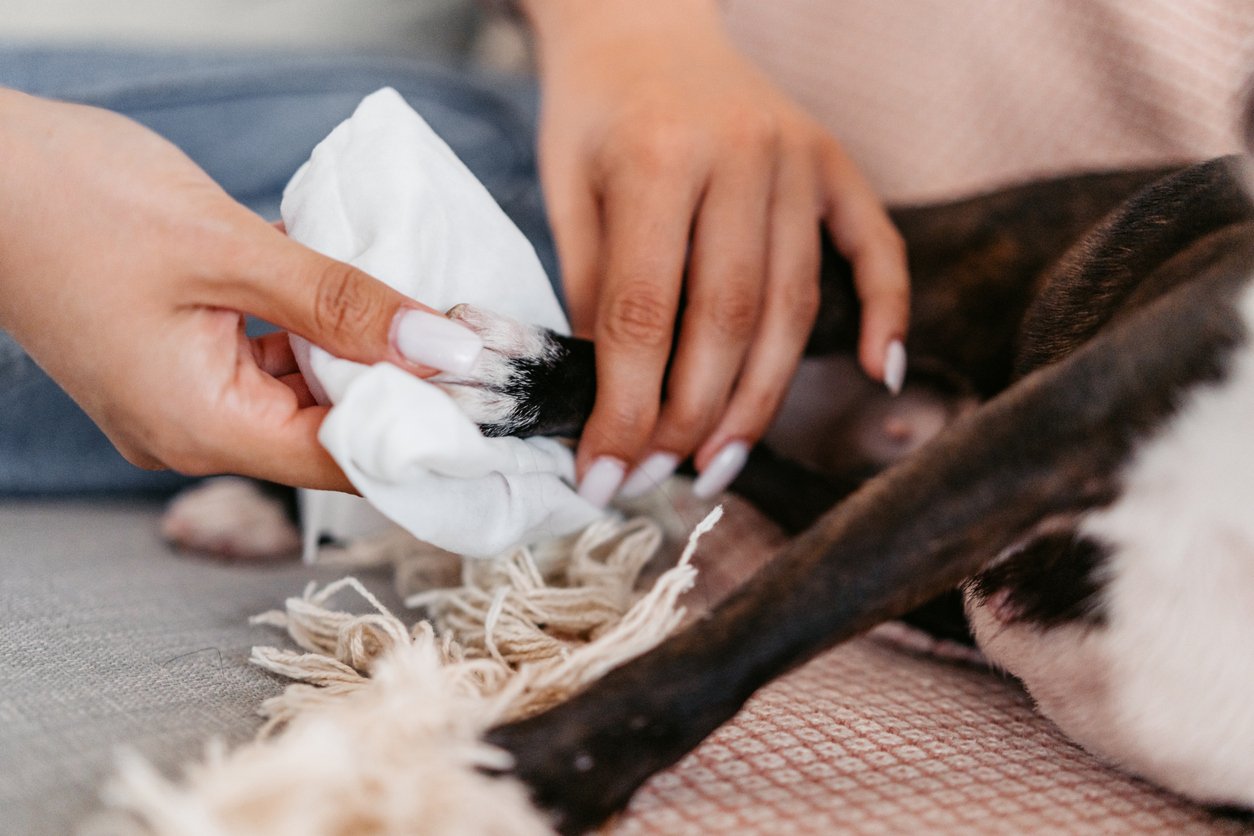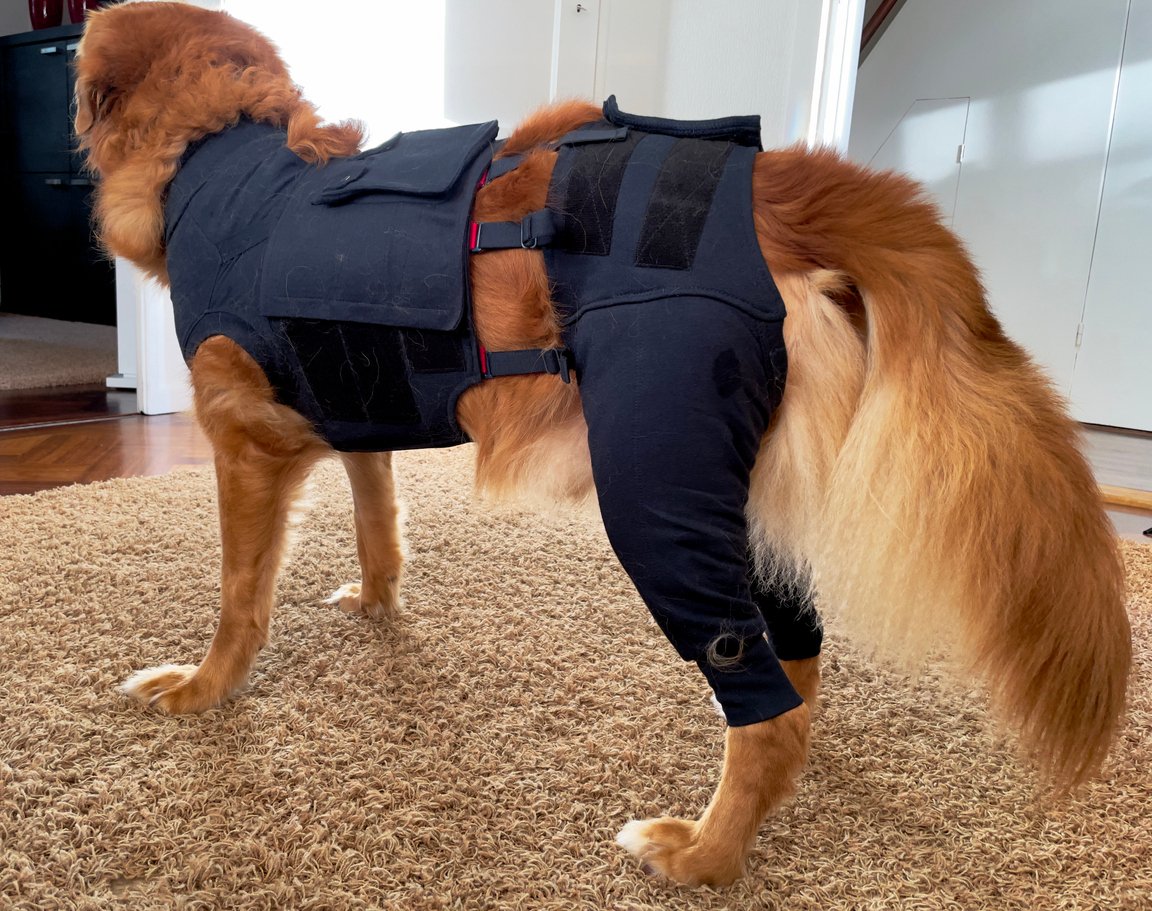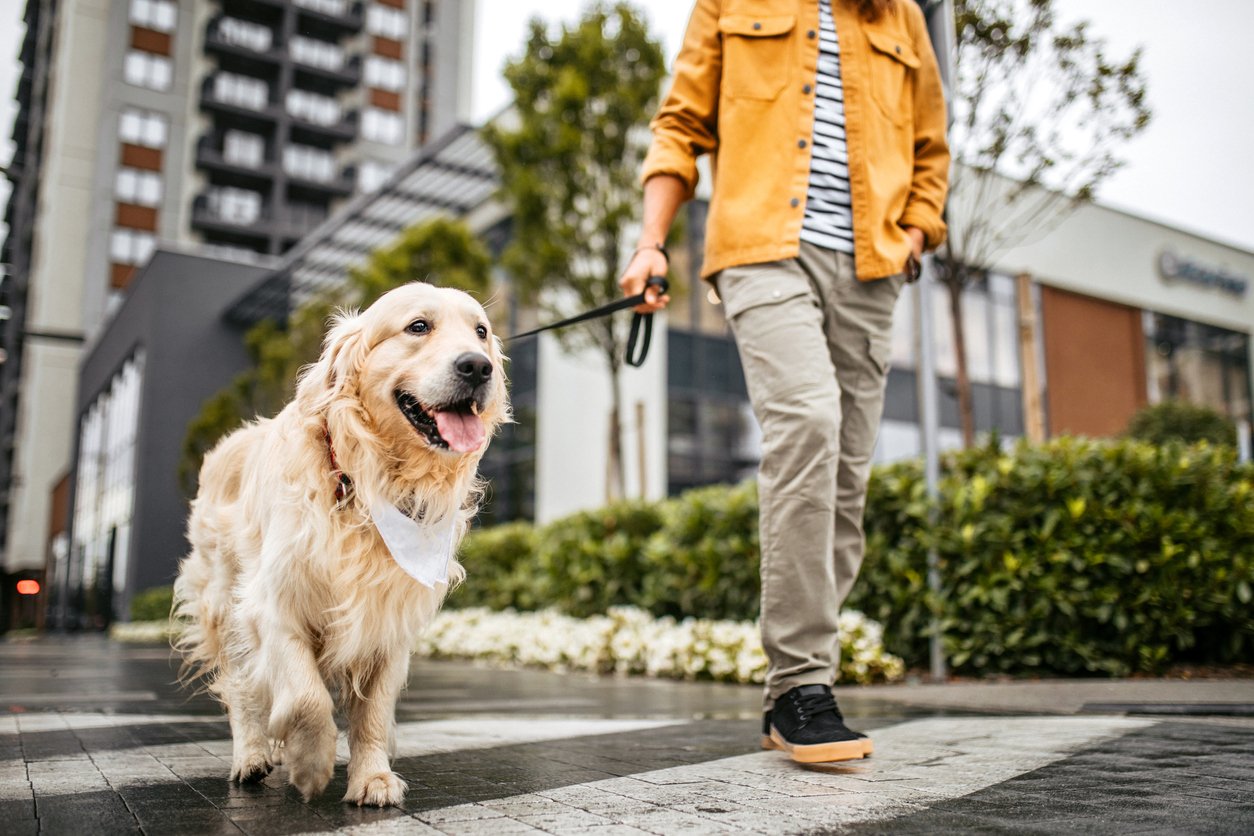Table of Contents
Pups are always getting into something! Dogs are energetic, playful and curious creatures, but can be prone to bumps and scrapes.
Imagine what kind of trouble you’d run into, exploring outside without shoes on? While dogs don’t typically need a pair of Nikes or hiking boots, their paws aren’t always resistant to a dog paw injury. One of the most common issues with canine feet is a dog paw yeast infection.
Dog paw yeast infections, also known as dermatitis, are caused by an overgrowth of yeast on a dog’s paws. The species of yeast is typically Malassezia pachydermatis. Dogs naturally have a small amount of yeast that lives on their skin; however, when it multiplies, it can manifest into itchy, red inflammation and sometimes infection.
If you’ve heard the sudden shriek of pain, noticed excessive licking, or sudden changes in gait, it’s time to check your pooch’s toes. Read on to learn about the common causes of a dog paw yeast infection, symptoms, and treatment options available.
What Makes a Dog Paw Yeast Infection Unique?
Dog foot pads also provide several unique benefits:
- Protect bones and joints in the feet
- Absorb shock from running and walking
- Provide insulation for hot and cold weather
- Aide with walking on uneven terrain
To understand where a dog paw yeast infection presents, it’s important to learn about the anatomy of a dog paw.
Check out the infographic below for a detailed visual of the dog paw anatomy.
The primary seven components of a dog paw are:
- Claw
- Digital Pads
- Metacarpal Pad (front paws)
- Metatarsal Pad (back paws)
- Dew Claw
- Carpal Pad (front paws)
- Tarsal Pad (back paws)
|
Dog Paw Anatomy |
Purpose |
|
Claw |
|
|
Digital Pads |
|
Metacarpal Pad |
|
Metatarsal Pad |
|
|
Dew Claw |
|
|
Carpal Pad |
|
|
Tarsal Pad |
|
Carpal pad injuries are fairly common paw injuries in dogs. The carpal pad is the pad which sits on your dog’s heel, and bears the wear and tear of running, walking and jumping.
Any dog paw injury is challenging to deal with, but one of the most stubborn of all is a
dog paw pad yeast infection.
Dog’s toes have a unique anatomy and sensitive skin compared to elsewhere of the paw. The interdigital skin is the area between a dog’s toes and footpads. While a dog paw yeast infection can occur on any part of the paw, the interdigital skin is where yeast tends to flourish.Dog paws are prone to yeast infections for several reasons:
- Constant friction and moisture
- Hidden and hard-to detect
- Increased sensitivity and pain
- High risk of licking and self-inflicted worsening
Constant Friction and Moisture
The interdigital skin between a canine toes is prone to dog paw yeast infections due to friction and moisture. If you notice a recurring yeast dog paw infection between toes or a wound that does not heal quickly, it is due to the following reasons:
- Anatomy: The area is not exposed to air to allow healing.
- Movement: The skin between the toes is thin and constantly flexes when a dog walks or runs.
- Moisture: The space between the toes promotes moisture buildup.
The anatomy and movements factors cause friction which can delay or prevent healing. Moisture buildup, from licking, seat of exposure to water, creates a warm, damp environment for bacteria and fungus growth, causing a fungus dog paw pad yeast infection.
Hidden and Hard-to-Detect
Despite being covered in fur, most external cuts on dogs’ bodies are easy to spot. Unlike a visible cut on a paw pad, a dog paw yeast infection is usually hard to detect until it becomes red, swollen, or infected. Dirt and debris frequently get trapped between the toes, making dog paw infections common and hard to treat.
Increased Sensitivity and Pain
Interdigital skin is highly sensitive and more susceptible to pain. This is due to the highly dense concentration of nerve endings in a dog’s paw pads, particularly in the webbing between their toes. Therefore, even small cuts and blisters between the toes can be very painful to a pup. You may notice signs such as limping, licking and a reluctance to walk.
High Risk of Licking and Self-Inflicted Worsening
It might be time to get the cone out if you notice your pup licking a dog paw yeast infection. While licking wounds is instinctive, excessive licking is never a good sign for pet owners.
Excessive licking a dog paw yeast infection can have the following negative effects:
- Introducing a bacterial infection.
- Aggravate the existing yeast infection.
- Reopen healing wounds.
- Provide a warm breeding ground for bacteria.
Irritation to the digital skin can cause inflammation, called interdigital furunculosis, or hot spots between the toes, known as pododermatitis.
Common Causes of Dog Paw Yeast Infections
Regardless of how well you try to prevent them, some breeds are genetically prone to yeast infections:
- Terriers
- Basset Hounds
- Poodles
- Cocker Spaniels
- Dachshunds
- Shetland Sheepdogs
There are various reasons why your pup might develop a dog paw yeast infection. Yeast infections occur for similar reasons that other bacterial infections do, such as cuts, infections and allergies.
Cuts, Scrapes, and Punctures
Dogs can be accident-prone. Unlike you or I, dogs don’t have the sense to spot hazards like broken glass, sharp pieces of metal or other sharp objects. Cuts, scrapes and punctures are very common causes of a mild dog paw yeast infection.
Even in the absence of hazardous man-made materials, dogs often cut their paws on natural foreign objects like thorns or sharp, rocky terrain. Splinters and embedded debris frequently lead to a dog paw yeast infection. Infections can start within a day of a scrape, so it’s very important to treat punctures to the paws immediately.
Infections and Inflammation
Quite often, a dog paw injury is caused by an infection or an ingrown hair. Bacterial and fungal infections cause visible swelling, typically accompanied by discharge and a foul odour. An ingrown hair usually causes less visible signs of swelling, and is localized to a hair follicle.
|
Dog Paw Yeast Infection |
Dog Paw Ingrown Hair |
|
|
It is important to note that if left untreated, an ingrown hair can become infected, leading to interdigital cysts.
Allergies and Skin Conditions
Pododermatitis is the broad term used in veterinary medicine to describe inflammation of the skin on a dog’s paws. The inflammation can affect the whole paw, or be localized to a specific area, such as the interdigital skin. It can occur as a result of various causes including allergies and skin conditions.
The most common allergies causing Pododermatitis include:
- Milk
- Beef or chicken
- Wheat
- Dust
- Mould
- Pollen
- Fleas
Environmental allergies, such as dust, mould and pollen, can be seasonal or situational. Food allergies can present suddenly, even if your dog has had the same diet for years.
Fleas can also cause an allergic reaction in some dogs, called flea allergy dermatitis. While all pets experience flea bites, some are allergic to the saliva from flea bites.
Senior dogs are more likely to develop yeast infections than younger pups due to their weakened immune systems, making them more prone to all types of infections.
Dog Paw Yeast Infection Symptoms
A dog paw yeast infection can be challenging to detect. The symptoms of paw yeast infections present similarly to other paw or leg injuries. Once you’ve ruled out swelling on the legs and paws, check between the pads of their paws and the interdigital skin for signs of irritation.
Visible Signs of Injury
You might need to look closely, but dog paw yeast infections typically display one or more visible signs of injury:
- Redness
- Swelling
- Open wounds
- Blood
- Pus or discharge
- Dry skin
- Burns
- Blisters
There may also be a crusty buildup of dried pus or blood, or a combination of both. While dry buildup may indicate healing, it is crucial to address injury, as it could easily reopen and start to bleed or get infected.
Behavioural Changes
We know something is up when our dog no longer wants to run, or is fully engaged in self-grooming rather than going outside to play. Behavioural changes are key indicators of injuries and infections in our pets.
Common behavioural changes of a dog paw yeast infection include:
- Excessive licking or chewing paws
- Limping
- Vocalizing
- Letharygy
|
Behavioural Change |
Explanation |
|
Excessive licking or chewing |
Dogs lick or chew irritation as a way to soothe inflammation. |
|
Limping |
Dogs will favour one leg over another and bare weight on the non-injured paw. |
|
Vocalizing |
Dogs will wince or yelp as a way to express their pain. |
|
Lethargy |
Dogs with an injury will be less inclined to run or play. |
If your dog is showing signs of lethargy accompanied by loss of appetite, and you notice physical signs of heat and swelling, it is important to call your veterinarian immediately as these are indicators of an infection.
Dog Paw Yeast Infection Treatment
How to treat dog paw yeast infection is fairly straightforward and can usually be performed at home. The best at home treatment options are anti-fungal wipes, sprays or shampoos designed to treat yeast infections. There are also several topical antifungal creams you can buy over-the-counter without the need for a veterinary visit.
In addition to antifungal treatments, you’ll likely need to do a little first aid to treat the underlying condition.
First Aid at Home
Knowing how to treat minor bumps and scrapes is a necessary component of dog care. Minor causes of paw yeast infections, such as cuts, scrapes and blisters can be cared for at home.
If you don’t already have first aid kit for your pet, consider putting together a medical supply box with the following essentials:
- Bandages
- Adhesive tape
- Gauze
- Antiseptic wipes
- Antibacterial ointment
- Hydrogen peroxide
- Tweezers
- Scissors
First aid at home for dog paw yeast infections includes the following steps:
- Identify the injury. If there is a visible cut, bite or blister, proceed with the next steps.
- Use sterile tweezers to remove any dirt, debris or splinters.
- Clean the wound using a sterile cloth or cotton balls with mild antibacterial soap and water. You may use antibacterial wipes if you’re on-the-go.
- If you’re at home, try a dog paw yeast infection soak by soaking the paw in mild soap and water for a few minutes.
- Apply antibacterial ointment.
- Cover the wound with gauze and secure with adhesive tape. If necessary, wrap the gauze with bandages to hold it in place.
- Check the wound several times daily to monitor for signs of infection.
You can follow first aid treatment with over-the-counter antifungal dog paw yeast infection medicine.
Start by bathing your dog from head to toe in a degreasing or cleansing shampoo containing selenium sulfide or benzoyl peroxide. Benzoyl peroxide is an ingredient used to treat bacterial infections and help reduces oiliness of the skin. Selenium sulfide is used particularly for treating yeast dermatitis, the condition that causes a fungus dog paw pad yeast infection.
Once your dog is fresh and clean, you can apply topical antifungal cream or spray. These can typically be purchased at a pet shop, or an online pet supply store. You can also try a dog paw yeast infection soak using diluted apple cider vinegar. Yeast cannot survive in highly acidic environments. Apple cider vinegar has a low pH, so it is thought to reduce the overall population of yeast on a dog’s skin.
Veterinary Treatments
In some cases, you might need veterinary treatments for a dog paw yeast infection. If there is persistent bleeding, signs of progressing infection, or a foreign object you cannot remove, call your vet for care.
Signs you need veterinary treatments for a dog paw yeast infection include:
- Moderate bleeding
- Pus or discharge
- Severe swelling
- Worsening symptoms
If the dog paw yeast infection symptoms do not improve after a few days following at-home treatment options, it’s time to book an appointment with your vet.
Common veterinary dog paw yeast infection medicine treatments include:
- NSAIDs (nonsteroidal anti-inflammatory drugs)
- Oral antifungal medications
- Topical antifungal medications
- Antibiotics
|
Veterinary Treatment |
Description |
|
NSAIDs (nonsteroidal anti-inflammatory drugs) |
|
|
Oral antifungal medications |
|
|
Topical antifungal medications |
|
|
Antibiotics |
|
In rare cases, your vet might recommend surgery to remove a foreign object causing a dog paw yeast infection. Surgical procedures are also recommended to remove infected tissues or drain an abscess that is unresponsive to other treatments.
Pain Management and Healing
Mild dog paw yeast infections caused by minor cuts and external injuries take a few days to a week to fully heal. Factors that affect healing time include the depth and length of the cut or wound, its location, and whether or not it has become infected.
Due to the nature of the paw, yeast infections in the interdigital skin can take 7-10 days, or even longer. Of course, keeping the area free from saliva, dirt and debris will help the recovery process.
The following tips can help speed up the recovery process of a dog paw injury between toes:
- Wear an e-collar to prevent licking the wound
- Keep your dog indoors as much as possible
- Avoid walking on dirt paths or grass
- Clean the wound regularly
- Keep the area dry
Managing Discomfort From a Dog Paw Yeast Infection
When your pup has a dog paw yeast infection, the limping and changes in gait can cause additional strain on the limbs and joints. Offering a dog joint supplement supports healthy joints by promoting healthy cartilage and maintaining collagen and connective tissues.
Maintaining proactive joint health can help prevent additional injuries that may arise from a dog paw yeast infection. TRI-ACTA is a Canadian-made joint supplement for pets delivering a potent blend of glucosamine for dogs, chondroitin, and Methylsulfonylmethane (MSM). Chondroitin and glucosamine work to reduce stiffness and increase mobility of healthy joints. MSM is a natural anti-inflammatory that can help soothe your dog’s paws and joints by reducing swelling.
TRI-ACTA H.A. for Pets
Our maximum strength formula is optimally designed to accelerate the formation of cartilage, minimize inflammation, expedite the healing process, and improve joint conditions.

Preventing Future Paw Injuries
Some dog paw pad yeast infections are unavoidable. Your pup might have a genetic predisposition to yeast infections, or encounter a paw injury you couldn’t have anticipated. That being said, there are several preventative measures you can take to reduce the chances of a dog paw yeast infection.
Keeping Your Dog’s Paws Clean and Trimmed
Proper grooming is essential dog care for preventing dog eye infections, infections in the paws, and elsewhere on the body. Keeping paws clean and free of dirt and debris reduces the risk of bacterial or fungal infections, should your dog have an open wound.
Pet owners often overlook the importance of trimming nails as part of a regular grooming routine. Overgrown nails are prone to breaking, which can cause bleeding or open wounds at the quick. Long nails also accumulate more dirt and debris, which can contaminate punctures and cause a dog paw yeast infection.
Protective Booties For Rough Terrain and Extreme Weather
They’re not just for aesthetics! While dog booties might be an adorable fashion choice, protective shoes are wonderful for preventing dog paw yeast infections.
Rough terrain and extreme weather conditions can cause cuts, burns or frostbite, all of which can lead to infection. Protective dog booties also enhance traction, preventing slips leading to other types of dog injuries.
Regular Checks For Signs & Symptoms of Dog Paw Yeast Infection
Excessive licking and chewing of the feet are one of the key indicators your dog might have a dog paw yeast infection or another issue with their paws. Vocalizing, lethargy and limping also also behavioural changes that something is wrong with your dog. However, sometimes our dogs have health concerns without presenting any behavioural symptoms.
Check your dog’s feet regularly for the following dog paw yeast infection symptoms:
- Redness
- Inflammation
- Crusty build-up
- Discharge
- Flaky skin
- Swelling
Regular checks of your dog’s body are an important part of good practices for dog health.
Dog Paw Yeast Infection: Final Thoughts
Paw injuries and infections are common and sometimes unavoidable. For playful, energetic creatures who love to run and play, a little wear and tear on the paws is expected. Paw and leg injuries can put added strain on the joints, especially when the issue takes longer for recovery.
Investing in a quality joint supplement like TRI-ACTA or maximum-strength TRI-ACTA H.A. with added Hyaluronic Acid, is a great way to be proactive with your dog’s joint health. Dog supplements, healthy diet, and regular exercise are great ways to promote the best for your dog’s health!
TRI-ACTA H.A. for Pets
Our maximum strength formula is optimally designed to accelerate the formation of cartilage, minimize inflammation, expedite the healing process, and improve joint conditions.

Newsletter Signup
Subscribe to our newsletter to receive the latest news and exclusive offers.
.jpg?height=2000&name=Cliick_Integricare-DISPLAY-REVISEDV2%20(1).jpg)
Proactive & Therapeutic Joint Supplements
When given daily, Integricare joint supplements recover bone and joint injuries faster and help prevent mobility injuries from happening in the first place.











